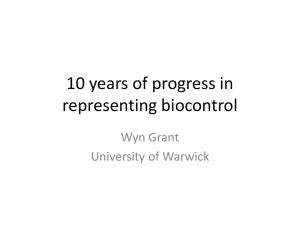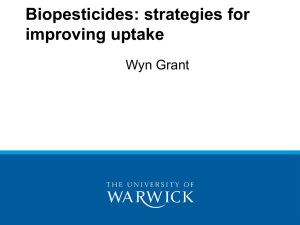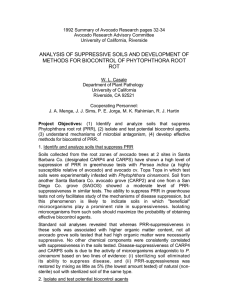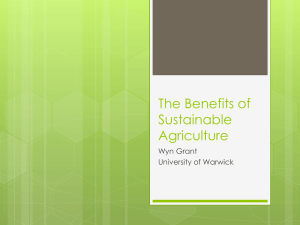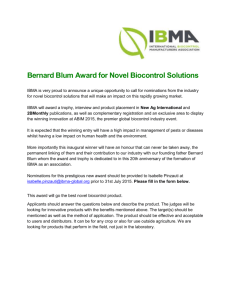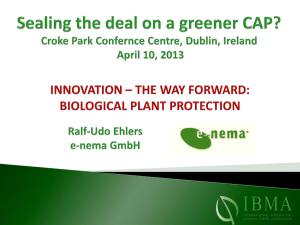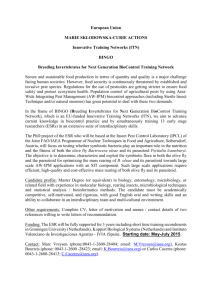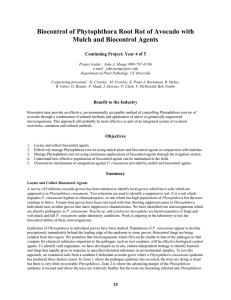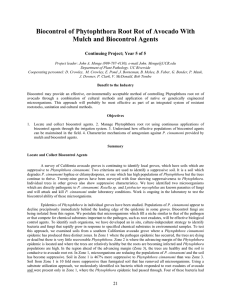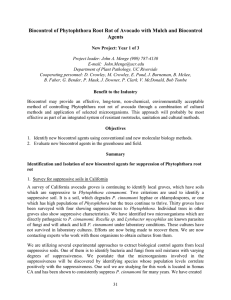1993 California Avocado Research Symposium Pages 48-50
advertisement
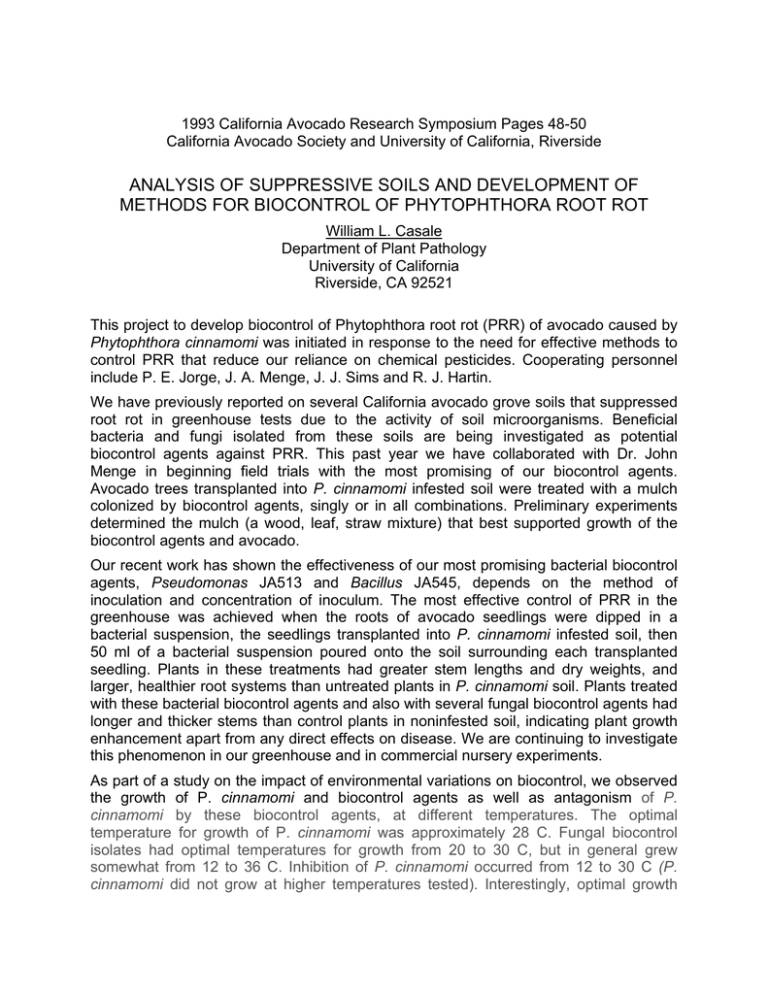
1993 California Avocado Research Symposium Pages 48-50 California Avocado Society and University of California, Riverside ANALYSIS OF SUPPRESSIVE SOILS AND DEVELOPMENT OF METHODS FOR BIOCONTROL OF PHYTOPHTHORA ROOT ROT William L. Casale Department of Plant Pathology University of California Riverside, CA 92521 This project to develop biocontrol of Phytophthora root rot (PRR) of avocado caused by Phytophthora cinnamomi was initiated in response to the need for effective methods to control PRR that reduce our reliance on chemical pesticides. Cooperating personnel include P. E. Jorge, J. A. Menge, J. J. Sims and R. J. Hartin. We have previously reported on several California avocado grove soils that suppressed root rot in greenhouse tests due to the activity of soil microorganisms. Beneficial bacteria and fungi isolated from these soils are being investigated as potential biocontrol agents against PRR. This past year we have collaborated with Dr. John Menge in beginning field trials with the most promising of our biocontrol agents. Avocado trees transplanted into P. cinnamomi infested soil were treated with a mulch colonized by biocontrol agents, singly or in all combinations. Preliminary experiments determined the mulch (a wood, leaf, straw mixture) that best supported growth of the biocontrol agents and avocado. Our recent work has shown the effectiveness of our most promising bacterial biocontrol agents, Pseudomonas JA513 and Bacillus JA545, depends on the method of inoculation and concentration of inoculum. The most effective control of PRR in the greenhouse was achieved when the roots of avocado seedlings were dipped in a bacterial suspension, the seedlings transplanted into P. cinnamomi infested soil, then 50 ml of a bacterial suspension poured onto the soil surrounding each transplanted seedling. Plants in these treatments had greater stem lengths and dry weights, and larger, healthier root systems than untreated plants in P. cinnamomi soil. Plants treated with these bacterial biocontrol agents and also with several fungal biocontrol agents had longer and thicker stems than control plants in noninfested soil, indicating plant growth enhancement apart from any direct effects on disease. We are continuing to investigate this phenomenon in our greenhouse and in commercial nursery experiments. As part of a study on the impact of environmental variations on biocontrol, we observed the growth of P. cinnamomi and biocontrol agents as well as antagonism of P. cinnamomi by these biocontrol agents, at different temperatures. The optimal temperature for growth of P. cinnamomi was approximately 28 C. Fungal biocontrol isolates had optimal temperatures for growth from 20 to 30 C, but in general grew somewhat from 12 to 36 C. Inhibition of P. cinnamomi occurred from 12 to 30 C (P. cinnamomi did not grow at higher temperatures tested). Interestingly, optimal growth temperature of the biocontrol agent was not always the best temperature for the inhibition of P. cinnamomi. Greenhouse experiments in temperature controlled water baths will be established to determine the effect of soil temperature on biocontrol of PRR. We compared the sensitivity of biocontrol agents and P. cinnamomi to the fungicides fosetyl-Al (Aliette) and metalaxyl (Ridomil) to determine the feasibility of limited use of fungicides in conjunction with biocontrol (Table 1). Ridomyl was not toxic to any of the biocontrol agents at the highest concentration tested (21.6 µg a.i./ml), whereas 154 times less Ridomil (0.14 µg a.i./ml) inhibited growth of P. cinnamomi by 90% (ID^) (Table 1). In contrast, the biocontrol agents were sensitive to Aliette, although 2.8 to 23 times higher concentrations of the fungicide were required to inhibit growth of biocontrol agents than growth of P. cinnamomi (Table 1). Based on these results, Ridomyl, but probably not Aliette, could potentially be used in conjugation with these biocontrol agents. The specificity of antibiotics produced by the biocontrol agent Verticillium KA190, previously determined to be inhibitory to several Phytophthora spp., was further tested using a wide variety of other groups of fungi represented by fungal biocontrol agents and plant pathogens. Extracts of KA190 cultures did not inhibit any of the nonPhytophthora fungi tested except an isolate of the plant pathogen, Sclerotium rolfsii, which was only inhibited at ten times the concentration of extract that inhibited growth of P. cinnamomi. Further work on characterization of the Phytophthora specific antibiotics from KA190 and the influence of environmental factors on antibiotic production is continuing.
